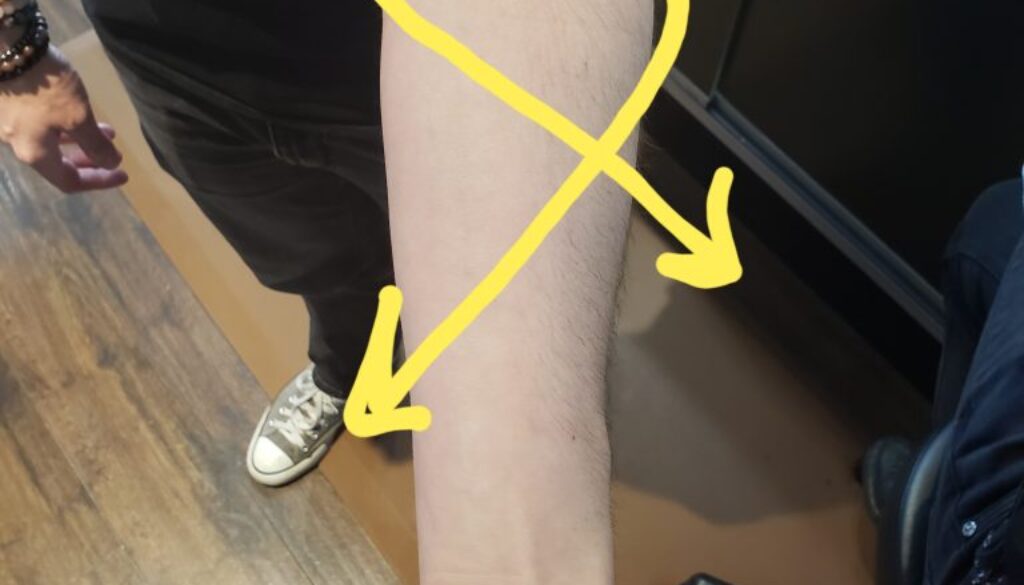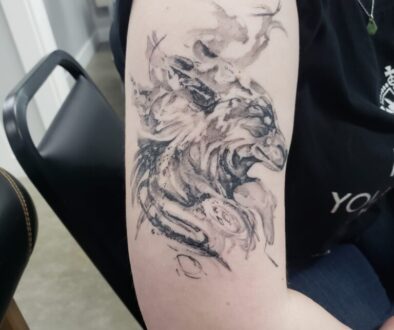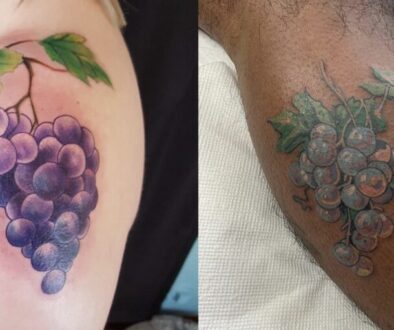Body Mapping – Tattoo Design
|
Listen to this Article::
|
Body Mapping in Large Scale – How to Fit Your Tattoo to the Body.
Table of Contents
Introduction to Body Mapping
Have you ever seen a tattoo on the web, on social media, or in real life that looks good? The subject matter may be simple, and the work may be mediocre, but there is something about that tattoo that just… well it works!?
Concepts to know before moving on
Focal Points:
A point in a design where you want the viewer to focus. It usually has a significant amount of detail and explains the design to the viewer. Are you tattooing a hummingbird and flowers with a washed-out background? What part of that tattoo would you like people to focus on? The bird, the background, or the flowers? Whatever the choice is, dump your details into that part of the design. The viewer will be directed to look at that part of the image first. The other design aspects will fill in the blanks and create a whole composition.
Transitions:
Aspects of the design that lead a viewer through the design. If you want to join multiple focal points, use these transitions to point and flow between every focal point. They can be subtle bits of soft shading or a foreground element that points to the focal point you want to be seen.
Viewpoint:
This is where, when the body is at rest, the focal point is viewable.
We now have that cleared up so, what is placement, and why does it matter in tattooing?
Body Mapping Basics – Elements
The skin
The skin is a fantastic organ. It covers our bodies, keeps us warm, and makes sure we don’t get sick from all the pathogens that lurk in every crevice of our existence. It also carries those rad designs we cover our bodies with. While I won’t detail the mechanics of the skin and how pigment interacts with it, I can tell you that your skin and how it interacts with your underlying tissues and bones influence how the tattoo will look once completed.
Look at my best friend’s forearm in all its glory!
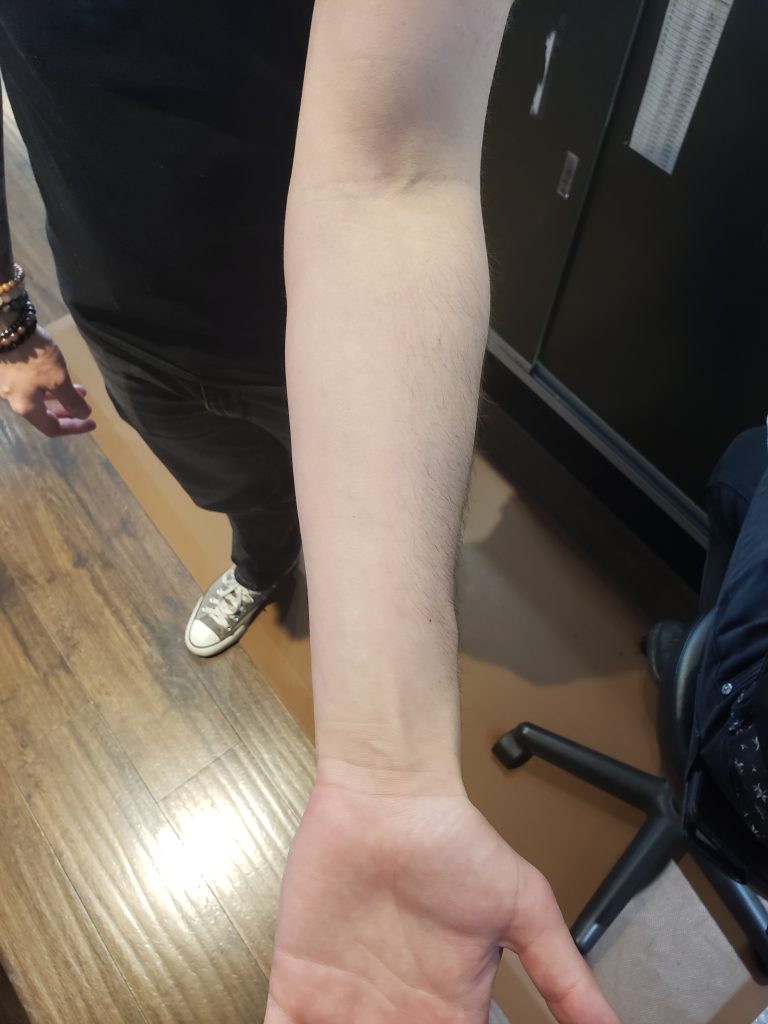
To the untrained eye, it is just an arm. I want you, the educated tattoo artist, to look a bit deeper and compare it to your arm.
Ask Yourself
- Is your arm and theirs the same?
- Do you have the same skin?
- Is it the same length?
- No to all the above. That was a simple set of answers, right?!
Body Mapping – We are not the same
If this arm and yours are not the same, how can we accurately place the same tattoo on both of your forearms and have them produce the same effect?
The answer is you cannot. Some modifications would have to be done so that any designs are custom-fit to each client. This is the idea behind “custom tattooing.” It has little to do with artwork that is custom made (anyone can draw an anchor); the tattoo is supposed to be custom-tailored to the individual. It is supposed to fit the contours and movement of the specific individual. In the case of a custom tattoo, it is one size fits one.
Things under the skin that influence tattoo designs.
The Muscles
What is underneath your skin? Yes, that is correct, muscles and bones. Muscles are responsible for your ability to move through the world. Your mass and strength can influence how your tattoo ages and how the world views it. Simply put, the muscles underneath your skin create hills and valleys that can distort and create movement in a design.
Do not let this deter you, though; knowing how these will influence the movement of your tattoo can add to the aesthetic and decrease the awkward effects of aging.
Bones
What is everything stacked on inside your body? Bones. They add structure and support, so you don’t end up with a gelatinous mass quivering on the floor. The bones are connected to the muscles by tendons and each other with ligaments. All that gooey mess inside your badass self is covered by your skin and gives you structure so you can move through the world.
What’s on top
Hair
Some people are sasquatches. That dense blanket of fur can affect how you view the image. Want to use a bug pin single to line this crispy daisy tattoo on ol’ biker Tom? Think again. That hair acts as a buffer that distorts any image you put into a person’s skin.
Scars
Burns, scrapes, cuts, and gunshots. These marks left over by your lazy ass body trying to fix some nasty wound can affect the results of your tattooing effort.
Knowing how the skin reacts to stress, as well as how it changes with age, will help you plan the perfect “custom” tattoo for your client because we know “custom” means “custom fit!”
Light details about what’s underneath
The muscles:
The muscles are a variable that constantly changes in all people. If you start working out, stop working out, get hurt, or, as is the certainty of all humans, age, your muscles will change in size and affect the skin above it. If that is so, how do we include this ever-changing variable into the design concept and placement?
First, look at the muscles in the area you are placing a tattoo. The muscle groupings have a stacked effect and create a crisscross pattern over most body parts. A grid of offset perpendicular lines is formed where the lines following the muscle groups meet.



Those perpendicular lines that form by tracing the muscles’ edges give you what I call distortion areas. These points are prone to movement whenever a person flexes or extends this part of their body.
Movement and body mapping
If you rotate your arm, pull or push your hand or grasp something with your fingers, those muscles are going to move. These lines can be placed anywhere the client may want to be tattooed as they all are boundaries as to where a muscle will affect the skin above it.
Putting a focal point or a static part of the image you are working with on top of these lines will create distortion whenever the person moves, so avoid that. These areas are best left for organic shapes and transitional elements of the tattoo that would benefit from distortion.
Work with the body
If you must place part or all of a focal point on top of a distortion area, do your best to place whatever curve or organic shape in line with what will move. It will cause a distortion but putting an aspect of the tattoo contrasting to the natural curves and movements of the body will make the final tattoo look out of place and age it prematurely.

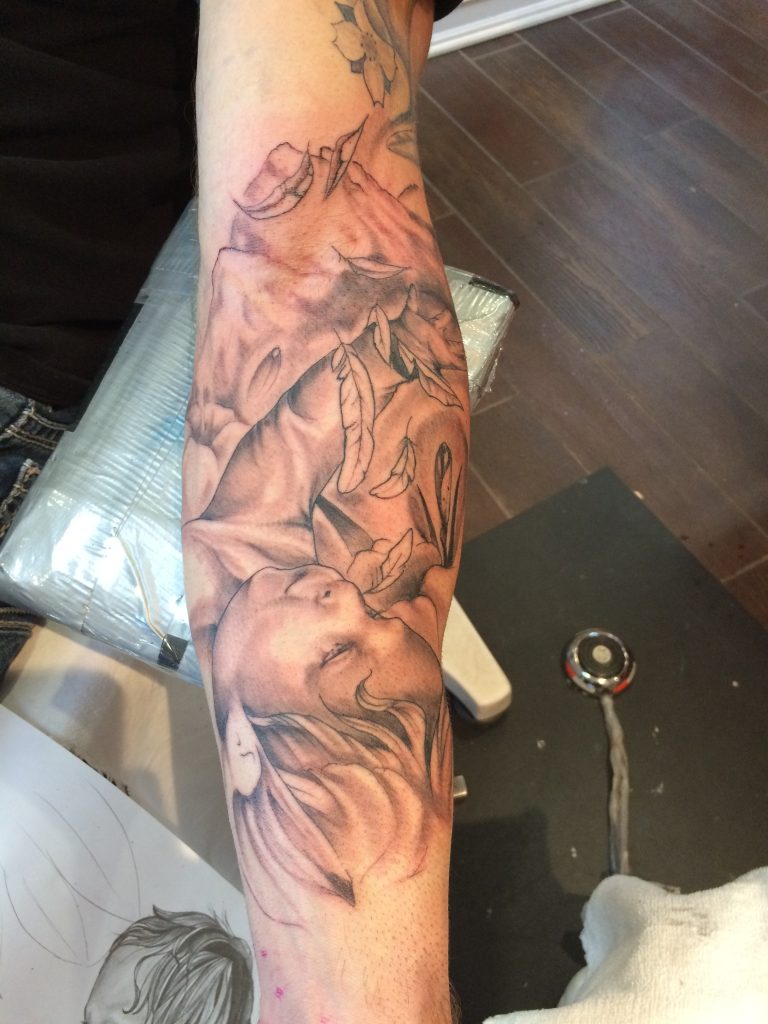
The appendages
Keep in mind that any point between 2 joints creates stress to the skin with muscles contraction. Your hands and feet are the most significant examples of this as they are highly mobile have many bones and a ton of muscles.
Moving closer to the heart, the forearms and lower legs have a higher incidence of torsion stress (twisting). You can see the torsion stress decreases as you move further in. Look at the gastrocnemius in the legs or the brachioradialis, flexors, and arm extensors. The lines they draw across those body areas show a distinct increase of torsion the further you move past them. However, they are quickly dealt with if approached correctly.
Connecting to the core
The upper thigh (quadriceps on the front and hamstrings in the back) and upper arm (biceps on the front and triceps on the back) create a tremendous amount of compression stress. Images placed here will crush and stretch to a higher degree than the other parts of the extremities.
The buttocks and Iliac muscles, The shoulders and chest
You can apply the same tracing aspects when mapping the buttocks or shoulder. The leg areas are broad, flat, and have torsion and compression stress. The shoulders work in tandem with the back and chest to rotate the upper arm, so you get a good amount of torsion stress when those are engaged. You also get a ton of compression on an image when someone lifts their arm in the air.
Remember to pay attention to the number of compressions and movement each place on the body exerts.
The chest and back, midsection, and neck
This shit stretches and twists a lot. These parts of the body are hypermobile, like the fingers, compared to the upper and lower extremities.
We will go into greater depth later in this article about how those movements affect your design, so read on!
“For those that want an in-depth look at muscles and how they interact with our body, follow this link.”
The Bones
While the bones are relatively static throughout our adult lives, they grow and constantly change during childhood and early adult years. The bones behind an image being placed onto the skin create stresses that modify the image. Look at how the bones connect at different pivot points, and with your new knowledge of how muscles work, see how the bones and their attachments affect the movement of muscles.
We attach a straight line to any bone when mapping that follows its course and a circle for any junction point that they adhere to (joints).
For an in-depth look at how the bones age, follow this link
https://www.ncbi.nlm.nih.gov/pmc/articles/PMC2991386/
Onto Body Mapping
This may seem like a large order, asking an artist to take the initiative in understanding what is going on with the tattoo’s placement, but there is a reason for such a task to be undertaken by you, dear reader. If you gain a working knowledge of this practice, your tattoos will better fit the body, be legible from a distance, and age better than others place incorrectly.
Let’s look at my besties arm again:

Imagine how the muscles contract and where things twist or bend. Where do the muscles underneath the skin cause distortions that could affect a tattoo? Do you notice something unique? How do you feel it is best to approach this aspect of mapping?
Let’s go into the paint program on my phone and start detailing a few aspects of this arm.
Body Mapping- What to look for.
As stated before, the joints on the body are usually denoted with a circle when mapping designs on the body.

The muscles create perpendicular lines that traverse the body section you are working with and move in opposite directions.
The bones create limitations in movement and structure that affect the muscles under the skin.
Creating a mess
If we put all of these together, you end up with a bit of a mess. It kind of looks like a demonic symbol, eh?

I know I may have lost you there but stick with me as you already know about the muscles, how they move and what stresses they exert on the body. We can utilize our knowledge to create a complex image that will age well.
Mapping with foreground and background elements
We use something that approximates a distorted figure 8, a loose “s” curve, or an infinity symbol when mapping out a design that is custom fit for the body.
Finding Muscle Lines
We can map and place foreground and background elements by utilizing the muscles and their contraction lengths. Trace the flow of each muscle grouping you are working with and find the points that the muscles crisscross to create perpendicular lines.
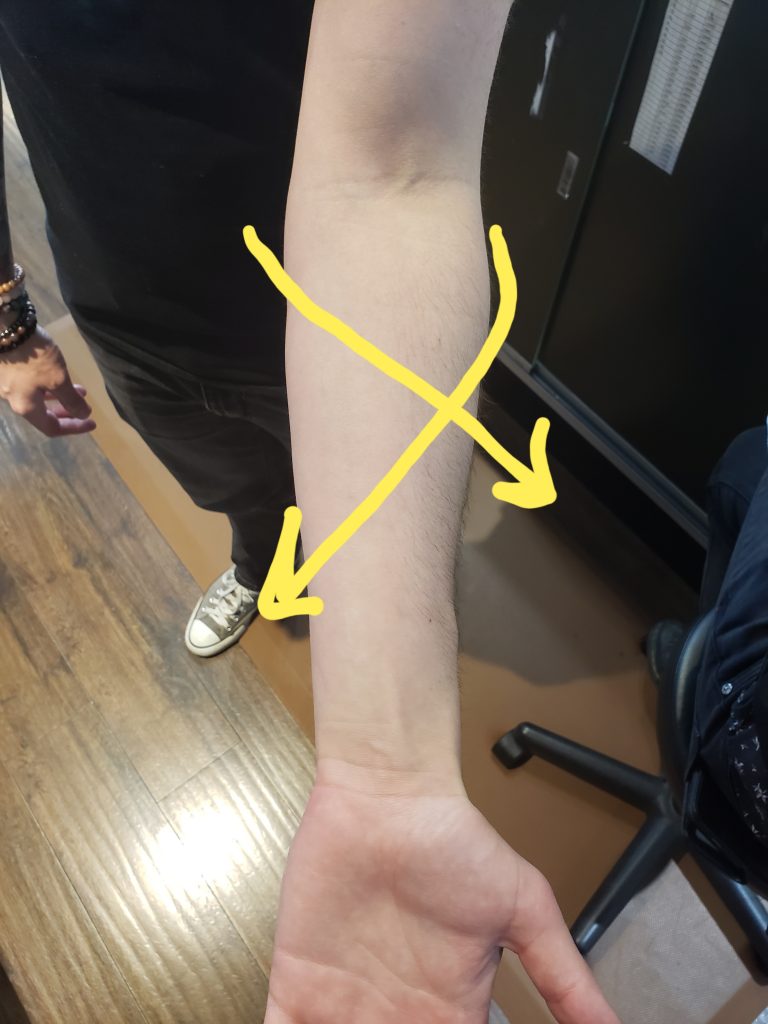
The perpendicular lines create the crossover you see above. Those lines and where they cross over each other can be made into the directional foreground or background elements in a tattoo design. These secondary elements can be utilized to create movement through and around an image by placing them on top of the muscle contraction lines you had mapped out (the dotted lines with arrows above).
Creating Flow
These flow lines indicate movement through the design and can move with the muscles as they contract or extend, giving the applied tattoo the ability to breathe and move with the person as they interact with their world and age. The flow lines also create a way of bypassing the joints that move through the appendages so that the designs can continue past the usual boundaries applied by the mobile joints.
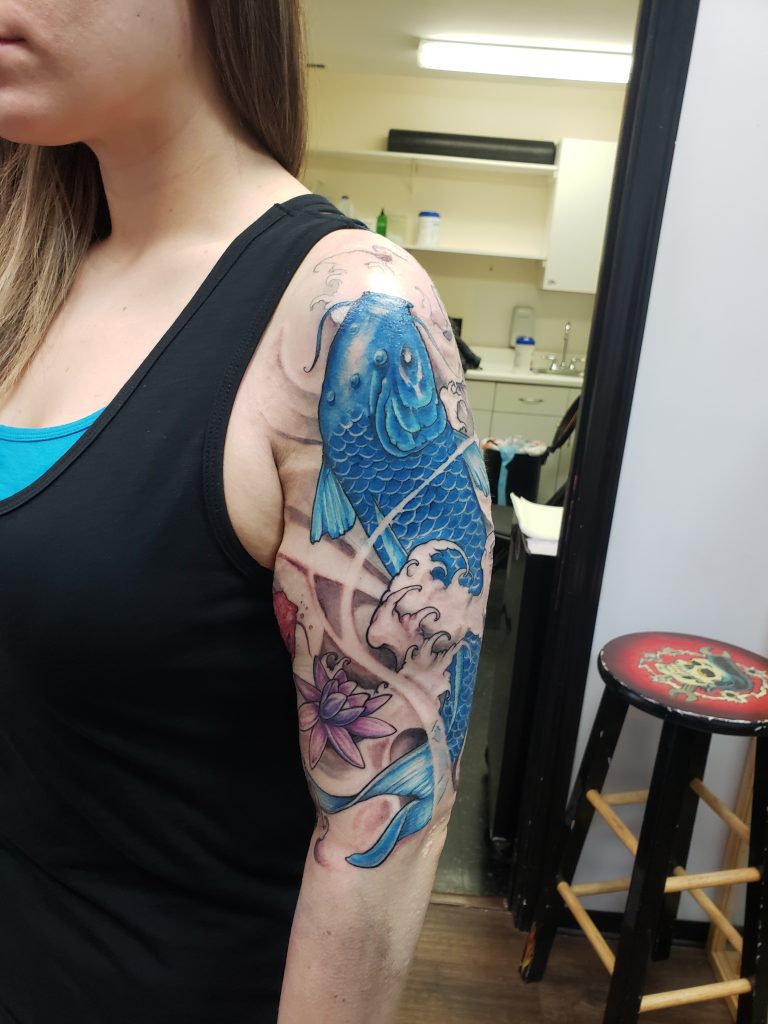
Finding Focal Points
Back to the arm again. I drew directly onto my friend’s skin to show you how I would approach finding the focal point areas and mapping where we can place those focal points to create multiple viewpoints.

I start mapping the body by finding the joints and drawing on an organic line that follows the contraction points and a muscle grouping.
One thing to notice is that the focal points aren’t aligned. This is important because the points where you want to put detail inside a tattoo aren’t competing for space.
To explain image focal point competition:
When you have a design placed with a ton of detail occupying the same linear space as another design that is detail-packed, your eyes will be forced to pick one.
A problem with competition
Our brains draw an imaginary line through the image that will bisect it as it tries to rectify what it should focus on. If you have multiple detailed designs competing for space, the brain (which is lazy) will try to look at both simultaneously.
The brain takes the competing images in and levels them out on the same plane of space. This makes an image look flat. Contrasting that idea, when you have multiple aspects of the tattoo working together with foreground and background elements, you end up with an organic piece that is mapped to the body and moves well with it. It gives depth and dimension to a piece and will work well as the tattoo ages.
Body Mapping and Distortion
Every part of the body you want to tattoo has different muscles that overlay bones. This technique isn’t relegated to the arms or legs, though, all sections of the body can be approached and mapped in the same fashion. Practice mapping out different areas and see how you can manipulate the more static parts located near the transitional areas where muscles contract and extend.
You can take your time and experiment with where each one of the different parts of your tattoo interacts with the skin by placing different stencils of the same image onto people’s skin and having them move around with them. Try moving foreground elements higher or lower, changing the focal point locations you have worked into the tattoo, and seeing how the design moves when placed onto different body parts.




Body Mapping – Conclusion
Taking in all of this information might give you a migraine, so work towards understanding the application slowly. Take a few minutes before and after each design and check to see if you can better map it to a body part. Is there any way you can increase the depth of the image or create better transitions between elements? Is there any competition between your focal points? Does your image look suitable from a distance as well as up close?

